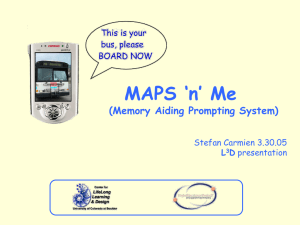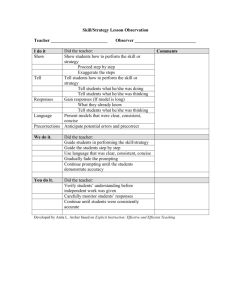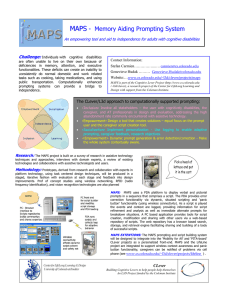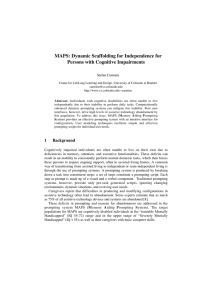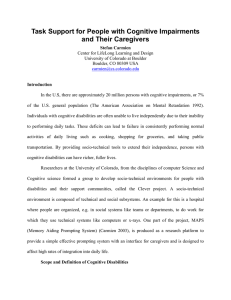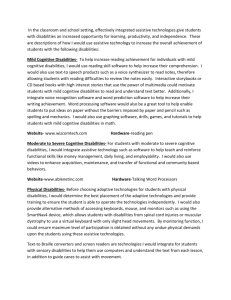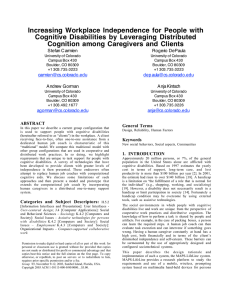MAPS: Creating Socio-Technical Environments in Support
advertisement
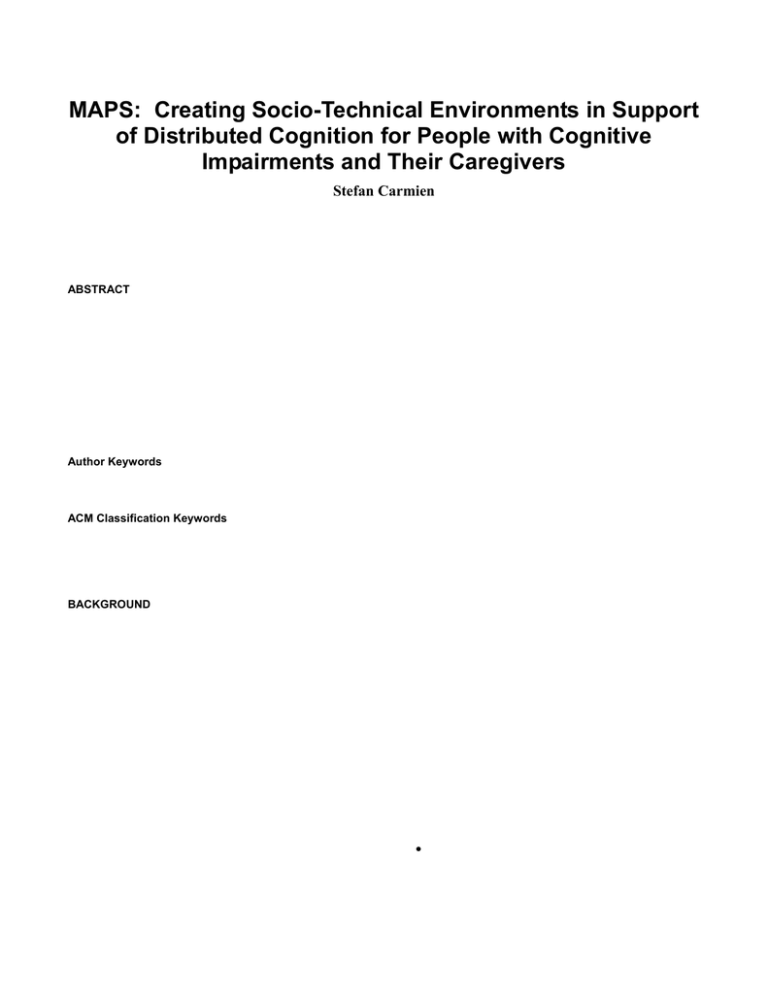
MAPS: Creating Socio-Technical Environments in Support of Distributed Cognition for People with Cognitive Impairments and Their Caregivers Stefan Carmien Center for LifeLong Learning and Design University of Colorado at Boulder Boulder, CO 80309 USA carmien@cs.colorado.edu ABSTRACT MAPS (Memory Aiding Prompting System), provides a simple effective prompting system for individuals with cognitive disabilities with an interface for caregivers. MAPS provides a socio-technical environment to increase their independence. MAPS contributes the base upon which a distributed support system can provide mobile, context-aware error detection and repair. The MAPS system utilizes and extends HCI frameworks, such as distributed cognition, situated action and end-user programming. Author Keywords Distributed cognition, end-user programming, assistive technology, technology abandonment, prompting systems. ACM Classification Keywords H.5.2 [Information Interfaces and Presentation]: User Interfaces - User-centered design; K.4.2 [Computers and Society]: Social Issues - Assistive technologies for persons with disabilities. BACKGROUND In the U.S., there are approximately 20 million persons with cognitive impairments [1]. Individuals with cognitive disabilities are often unable to live independently due to their inability to perform daily tasks such as cooking, shopping for groceries, and taking public transportation. By providing socio-technical tools to extend their independence, persons with cognitive disabilities can have richer, fuller lives. Traditionally, support has been provided by training: performing tasks utilizing prompting and task segmentation techniques. A script is created, consisting of linked sets of images and verbal prompts that together ‘pilot’ the user thru accomplishing the task. Having learned a specific task individuals then go into the ‘world’ with new skills. However some individuals lack the capacity to memorize and properly recall the steps necessary for some tasks and the context of the task as well as the task itself may change, rendering useless the training. Recent advances in computer technology: powerful PDA devices, ubiquitous wireless networking, and sensor technology have provided an opportunity to create prompting systems that could remedy this problem. A substantial portion of all assistive technology is abandoned after initial purchase and use, as high as 70% in some cases [2]. A large component of the cause for such abandonment is difficulty in configuring and adapting (re-configuring) software. My research platform, MAPS, provides an effective prompting system with an intuitive interface for configuration. This system, in concert with LifeLine[3], provides support for a wireless safety net that affords error detection and correction by dynamically pushing corrective prompts and/or summoning appropriate levels of external assistance. MAPS attends to the particular interface requirements for users with cognitive impairments, views the configuration and other caregiver tasks as different and equally important requirements for a second user interface, and applies techniques such as taskoriented design. The design of the script editor (a tool that enables caregivers to create, store and edit scripts) presents problems particular to meta-design [4]. In most applications of meta-design, the designer and end-user are one in the same person. In this application domain, I am designing a tool that allows users (caregivers) to create systems that are used by other users (a person with cognitive disabilities). My research is driven by three overarching concerns: • Creating a fundamental understanding of how people with moderate to severe cognitive disabilities perceive and use information in prompting systems for tasks on mobile handheld devices; • User-centered development of a non-technical caregiver environment that supports mobile device customization, personalization and configuration; • Developing a principled understanding of how real-time caregiver/service provider interfaces provide unobtrusive, remote supervision and computationallybased breakdown detection and recovery[5]. The target populations for MAPS are cognitively disabled individuals in the ‘trainable Mentally Handicapped’ (IQ 55-72) range and in the upper range of ‘Severely Mentally Handicapped’ (IQ < 55); as well as the caregivers who would compose MAPS scripts. RELATED RESEARCH Studies in distributed cognition, learning and using on demand, activity theory, and situated cognition [6] provide a theoretical basis for this research. Prompting studies provide a background for design and study of computationally based prompting systems [7]. There is a small body of literature concerning design and implementation of assistive technology [8]. Existing computer based prompting tools provide information to base design and theoretical inferences. Of interest is the Visions System [9] based prompting and scheduling tool using touch screens to prompt thru tasks like cooking. PDA-based systems include the Able Link team’s ‘Pocket Coach’[10] and the Swedish Isaac project [11]. DESIGN The MAPS system is composed of a PDA prompter and PC based script editor tool. Studies of the user populations produced requirements for the system, including appropriate modification of PDA controls, wireless connectivity for dynamic, context based prompt generation and ‘panic button’ functionality. The caregiver interface, utilizing web-based repositories of scripts and script templates, was designed with AT (assistive technology) experts and caregivers input. The interfaces for the installer and ongoing changes are targeted at non-computer professionals. Innovative aspects of MAPS design include dynamic error detection and correction in concert with the LifeLine research project[3], wireless dynamic prompt generation and using user-modeling techniques to implement templates for task-type error detection and correction. DEPLOYMENT AND EVALUATION PLANS Both the PDA prompter and the script generator/editor have been prototyped. Initial usability studies of the prompter and scripter interfaces have been done with the target population. Ongoing are task-to-script guideline evaluation, and studies to base heuristics for image attributes and script text. Initial integration of the MAPS and LifeLine systems for context awareness and dynamic error detection/correction has been accomplished. Finally a round of system evaluation experiments and analysis will be performed. OPEN ISSUES and NEXT STEPS The full scope of my research, beyond implementing and evaluating of the prompter and script editor, includes utilizing and evaluating user modeling techniques to create individual ‘templates’ for script design, error detection and correction for specific task domains, such as using public transportation, or shopping. Implementing and evaluating context sensitive dynamic prompt generation, such as in the case of a bus delay or missed connection constitutes the second challenge in my research. Finally the issues of usability evaluation, while well covered in more traditional populations, will provide a challenge in evaluating and refining the interface for the cognitively disabled population. ACKNOWLEDGMENTS I thank the members of the CLever research team and my advisor Gerhard Fischer. The Coleman foundation provided financial support for this research. REFERENCES 1. The American Association on Mental Retardation, AAMR definition of Mental Retardation. 2. Philips, B. and H. Zhao, Predictors of assistive technology abandonment. Assistive Technology, 5 (1993), 36-45. 3. LifeLine Project. http://www.cs.colorado.edu/~l3d/clever/projects/lifelin e.html. 4. Fischer, G. and Scharff, E. Meta-Design—Design for Designers. 3rd International Conference on Designing Interactive Systems (DIS 2000), ACM (2000). 5. Carmien, S., et al. Increasing Workplace Independence for People with Cognitive Disabilities by Leveraging Distributed Cognition among Caregivers and Clients. ACM 2003 International Conference on Supporting Group Work (GROUP '03) (2003). 6. Suchman, L.A., Plans and Situated Actions The Problem of Human Machine Communication. Cambridge University Press, Cambridge, UK, 1987. 7. Lancioni, G., et al. Evaluation of a Computer-aided System Providing Pictorial Task Instructions and Prompts to People with Severe Intellectual Disability. Journal of Intellectual Disability Research, 43(1), (1999), 61-66. 8. King, T., Assistive Technology – Essential Human Factors. Allyn & Bacon, Boston, 1999. 9. Baesman, B., The Visions System. http://www.thevisionssystem.com. 10. AbleLink, Visual Impact memory and skill prompter. http://www.ablelinktech.com/. 11. Jönsson, B., Isaac project. http://www.english.certec.lth.se/Isaac/.
